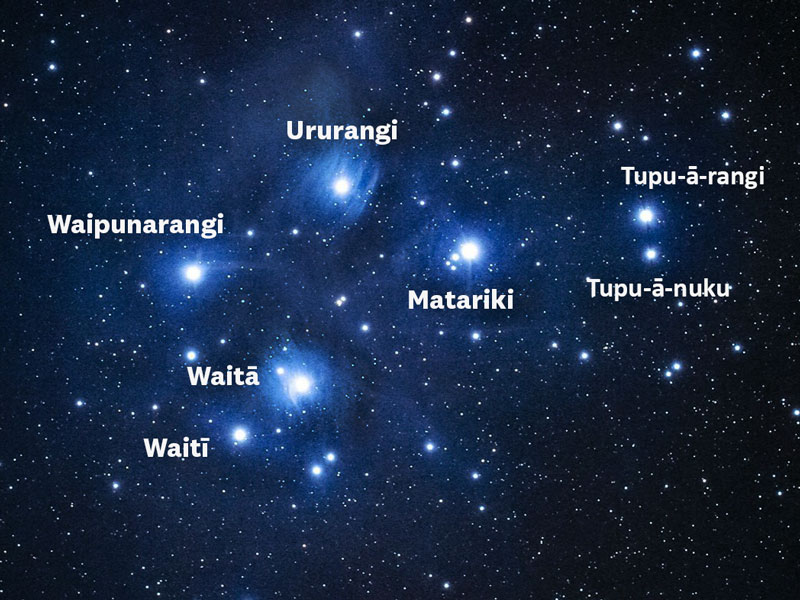Mother and Six Daughters – Matariki
REGION
New Zealand
New Zealand
OBJECT
Pleiades
Pleiades
SOURCE
Adapted from “The legend of Matariki and the six sisters”, Museum of New Zealand, https://www.tepapa.govt.nz/legend-matariki-and-six-sisters
Adapted from “The legend of Matariki and the six sisters”, Museum of New Zealand, https://www.tepapa.govt.nz/legend-matariki-and-six-sisters
There are many legends about the star cluster Matariki. One of the most popular is that the star Matariki is the whaea (mother), surrounded by her six daughters, Tupu-ā-nuku, Tupu-ā-rangi, Waipunarangi, Waitī and Waitā, and Ururangi.
Matariki and her daughters journey across the sky each year to visit their tupuna wahine (great grandmother), Papatūānuku (Mother Earth). During this visit, each of the stars help Papatūānuku to prepare for the year to come, using their unique qualities or gifts to bring mauri (life force or energy) to her different environments.
Whilst spending time with their kuia (grandmother), they also learn new skills and gain new knowledge from her, which they guard and pass on to others.
 Image: Fraser Gunn www.astroimage.co.nz
Image: Fraser Gunn www.astroimage.co.nzEthnologist Elsdon Best translated Matariki as ‘little eyes’ or ‘small eyes’ (mata = eye, riki = small). However, the name comes from the phrase ‘Ngā mata o te ariki Tāwhirimātea’, ‘the eyes of the god Tāwhirimātea’.
This name finds its origins in the separation of Ranginui and Papatūānuku. After Tāne separated the sky from the earth, Tāwhirimātea waged war against him and the other gods, for he wanted his parents to remain together. He battled with all of his brothers until he was defeated by Tūmatauenga, the Māori god of warfare and mankind. In a display of rage against his brothers and a sign of love for his father, Tāwhirimātea plucked out his eyes, crushed them in his hands, and threw them into the sky where they stuck to his father’s chest and became the stars of Matariki.
For many cultures, these stars are connected to celebration, planting, harvesting, weather, and life. For Māori, the rising of Matariki signals te Mātahi o te Tau, the Māori New Year. The appearance of Matariki in the morning sky is a sign for people to gather, to honour the dead, celebrate the present, and plan for the future.
Matariki sets on the western horizon in the evening around the beginning of winter during the lunar period of Takurua. It is at this time that Matariki disappears from view because of the light of the sun. About a month after it disappears, Matariki is seen again on the eastern horizon just before sunrise. Its reappearance coincides with mid-winter and marks the beginning of the Māori New Year. Many Māori communities would wait for the lunar period of Tangaroa to observe Matariki and to begin their celebrations.
Matariki happens during the coldest time of year. For the ancestors of Māori it was a time when the major work activities had come to an end: the harvest was over and food from the gardens had been gathered and stored away in pits and pātaka in preparation for winter. When the Matariki stars rose, it was a time to come together to farewell the dead, spend time with loved ones, share kai, stories, waiata, and celebrate the New Year.